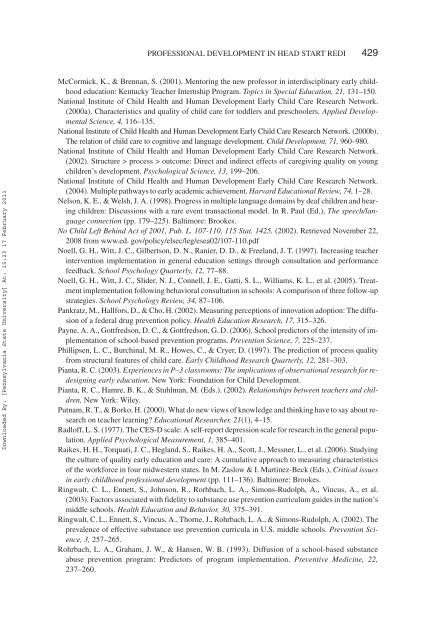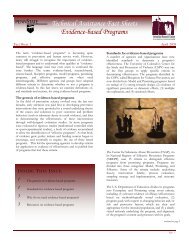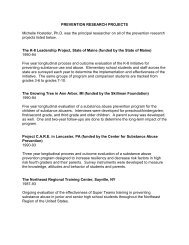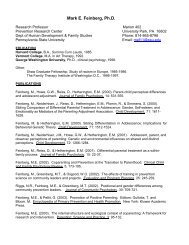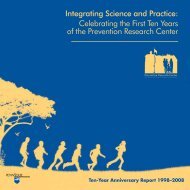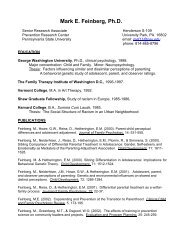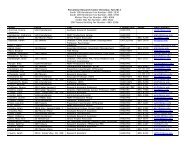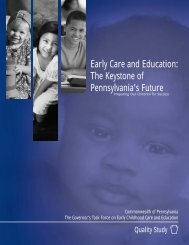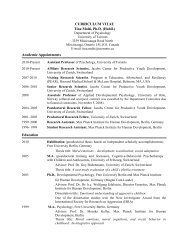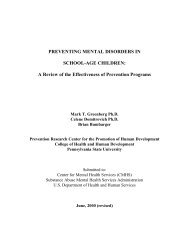Early Education & Development Individual Factors Associated With ...
Early Education & Development Individual Factors Associated With ...
Early Education & Development Individual Factors Associated With ...
You also want an ePaper? Increase the reach of your titles
YUMPU automatically turns print PDFs into web optimized ePapers that Google loves.
PROFESSIONAL DEVELOPMENT IN HEAD START REDI 429<br />
Downloaded By: [Pennsylvania State University] At: 15:23 17 February 2011<br />
McCormick, K., & Brennan, S. (2001). Mentoring the new professor in interdisciplinary early childhood<br />
education: Kentucky Teacher Internship Program. Topics in Special <strong>Education</strong>, 21, 131–150.<br />
National Institute of Child Health and Human <strong>Development</strong> <strong>Early</strong> Child Care Research Network.<br />
(2000a). Characteristics and quality of child care for toddlers and preschoolers. Applied <strong>Development</strong>al<br />
Science, 4, 116–135.<br />
National Institute of Child Health and Human <strong>Development</strong> <strong>Early</strong> Child Care Research Network. (2000b).<br />
The relation of child care to cognitive and language development. Child <strong>Development</strong>, 71, 960–980.<br />
National Institute of Child Health and Human <strong>Development</strong> <strong>Early</strong> Child Care Research Network.<br />
(2002). Structure > process > outcome: Direct and indirect effects of caregiving quality on young<br />
children’s development. Psychological Science, 13, 199–206.<br />
National Institute of Child Health and Human <strong>Development</strong> <strong>Early</strong> Child Care Research Network.<br />
(2004). Multiple pathways to early academic achievement. Harvard <strong>Education</strong>al Review, 74, 1–28.<br />
Nelson, K. E., & Welsh, J. A. (1998). Progress in multiple language domains by deaf children and hearing<br />
children: Discussions with a rare event transactional model. In R. Paul (Ed.), The speech/language<br />
connection (pp. 179–225). Baltimore: Brookes.<br />
No Child Left Behind Act of 2001, Pub. L. 107-110, 115 Stat. 1425. (2002). Retrieved November 22,<br />
2008 from www.ed. gov/policy/elsec/leg/esea02/107-110.pdf<br />
Noell, G. H., Witt, J. C., Gilbertson, D. N., Ranier, D. D., & Freeland, J. T. (1997). Increasing teacher<br />
intervention implementation in general education settings through consultation and performance<br />
feedback. School Psychology Quarterly, 12, 77–88.<br />
Noell, G. H., Witt, J. C., Slider, N. J., Connell, J. E., Gatti, S. L., Williams, K. L., et al. (2005). Treatment<br />
implementation following behavioral consultation in schools: A comparison of three follow-up<br />
strategies. School Psychology Review, 34, 87–106.<br />
Pankratz, M., Hallfors, D., & Cho, H. (2002). Measuring perceptions of innovation adoption: The diffusion<br />
of a federal drug prevention policy. Health <strong>Education</strong> Research, 17, 315–326.<br />
Payne, A. A., Gottfredson, D. C., & Gottfredson, G. D. (2006). School predictors of the intensity of implementation<br />
of school-based prevention programs. Prevention Science, 7, 225–237.<br />
Phillipsen, L. C., Burchinal, M. R., Howes, C., & Cryer, D. (1997). The prediction of process quality<br />
from structural features of child care. <strong>Early</strong> Childhood Research Quarterly, 12, 281–303.<br />
Pianta, R. C. (2003). Experiences in P–3 classrooms: The implications of observational research for redesigning<br />
early education. New York: Foundation for Child <strong>Development</strong>.<br />
Pianta, R. C., Hamre, B. K., & Stuhlman, M. (Eds.). (2002). Relationships between teachers and children.<br />
New York: Wiley.<br />
Putnam, R. T., & Borko, H. (2000). What do new views of knowledge and thinking have to say about research<br />
on teacher learning <strong>Education</strong>al Researcher, 21(1), 4–15.<br />
Radloff, L. S. (1977). The CES-D scale: A self-report depression scale for research in the general population.<br />
Applied Psychological Measurement, 1, 385–401.<br />
Raikes, H. H., Torquati, J. C., Hegland, S., Raikes, H. A., Scott, J., Messner, L., et al. (2006). Studying<br />
the culture of quality early education and care: A cumulative approach to measuring characteristics<br />
of the workforce in four midwestern states. In M. Zaslow & I. Martinez-Beck (Eds.), Critical issues<br />
in early childhood professional development (pp. 111–136). Baltimore: Brookes.<br />
Ringwalt, C. L., Ennett, S., Johnson, R., Rorhbach, L. A., Simons-Rudolph, A., Vincus, A., et al.<br />
(2003). <strong>Factors</strong> associated with fidelity to substance use prevention curriculum guides in the nation’s<br />
middle schools. Health <strong>Education</strong> and Behavior, 30, 375–391.<br />
Ringwalt, C. L., Ennett, S., Vincus, A., Thorne, J., Rohrbach, L. A., & Simons-Rudolph, A. (2002). The<br />
prevalence of effective substance use prevention curricula in U.S. middle schools. Prevention Science,<br />
3, 257–265.<br />
Rohrbach, L. A., Graham, J. W., & Hansen, W. B. (1993). Diffusion of a school-based substance<br />
abuse prevention program: Predictors of program implementation. Preventive Medicine, 22,<br />
237–260.


